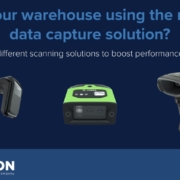Today’s consumer demands require faster, more accurate, 24/7 fulfillment in warehouses and distribution centers. Businesses need trusted performance to identify, measure, track, and inspect items from production through distribution to deliver goods faster. Increasing numbers of businesses agree that implementing automation is the easiest and most efficient way to achieve fast fulfillment. Studies show that 80% of organizations plan to invest in new technologies to be competitive, while 70% of warehouse decision-makers need to modernize their warehouse operations–but admit they are slow to implement new devices and technology.
Warehouses with slower operations run the risk of losing customers, frustrating workers and enabling errors. To prevent these issues, automation experts suggest deploying strategies such as:
- Streamlining data collection – When workers pause to collect data, they create a significant time drag and diminish efficiency. While this can happen potentially thousands of times a day, an autonomous automated solution can eliminate downtime and free up workers to focus on more skilled, non-repetitive tasks.
- Choosing smarter scanning capabilities – Innovative and automated scanning technologies can be affordable, flexible and easy to deploy. Flexibility and easy integration offer simple management to make warehouse operations more efficient and workers’ days easier. Simplified integration also can help reduce training times so warehouses are more prepared for consumer demands.
- Implementing flexible barcode readers – Industrial scanners can boost scanning capabilities by gathering data from numerous items at once. Handheld scanners with expanded read ranges and variable-distance barcode reading ensures your workers get the data they need quickly and with fewer steps.
- Reducing downtime with automated scanning – Industrial scanning solutions grow with your business and adapt to changing operational demands with flexible and durable designs. Smart automation withstands challenging conditions like warehouse environments to reduce time spent on repairs and maximize mobility.
Speed is the top priority when it comes to fulfillment and consumer expectations. Innovative solutions like industrial scanners can improve order picking and packing speeds without compromising accuracy or workflow management. Automated scanning technology provides trusted performance for the distribution process with:
- Accelerated shipment handling
- Increased efficiency
- Decreased downtime
- Streamlined workflows
- Improved accuracy
- Reduced risk
Improved warehouse operations and order fulfillment are achievable with innovative automated scanning technology. Learn more about how your business can improve accuracy and decrease downtime to surpass consumer expectations.




